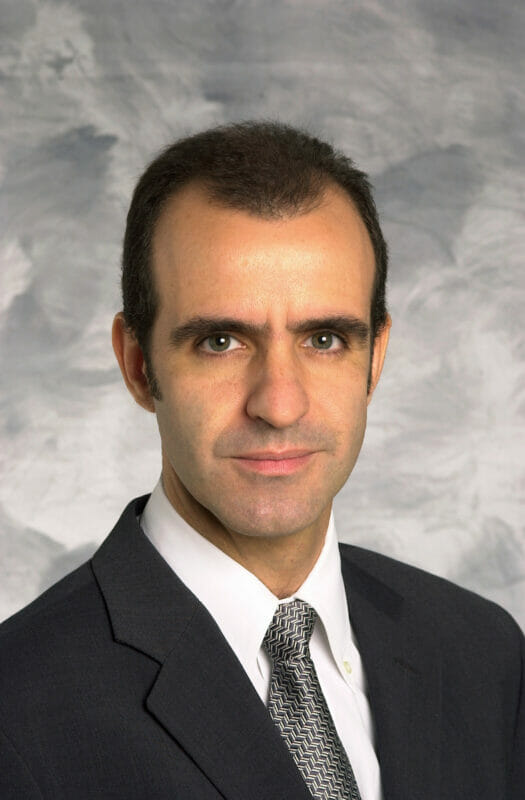
Josep Rutllant, DVM, PhD
Professor of Anatomy, Co-Director Phase I
College of Veterinary Medicine
PhD, Autonomous University of Barcelona, Barcelona, Spain 1997
DVM, Autonomous University of Barcelona, Barcelona, Spain 1990
•2002-2003: Lecturer at the Department of Anatomy, Physiology and Cell Biology, School of Veterinary Medicine, University of California-Davis
•2001-2002: Visiting Associate Professor at the Department of Anatomy, Physiology and Cell Biology, School of Veterinary Medicine, University of California-Davis
•2000-2001: Scientific Stay (total five months) - Visiting Scientist in the Department of Anatomy, Physiology, and Cell Biology, School of Veterinary Medicine, University of California-Davis, CA (Dr. Stuart Meyers)
•2000-2001: Associate Professor at the Department of Animal Health and Anatomy, School of Veterinary Medicine, Autonomous University of Barcelona,
•1998-1999: NATO Postdoctoral Fellowship, Center for Animal Transgenesis and Germ Cell Research, University of Pennsylvania School of Veterinary Medicine, New Bolton Center, PA
•1998-1999: Scientific Stay (total one year, two months) - Postdoctoral position in the Department of Clinical Studies, Center for Animal Transgenesis and Germ Cell Research, University of Pennsylvania School of Veterinary Medicine, New Bolton Center, PA (Dr. Stuart Meyers)
•1997: PhD degree in Veterinary Medicine, School of Veterinary Medicine, Autonomous University of Barcelona (Cum Laude) [Advisors Dr. Fernando Lopez-Gatius, University of Lleida; and Dr. Joaquin Camon, Complutense University of Madrid]
•1991-1998: Scientific Stay (total one year)- Different periods, the Department of Animal Sciences, University of Lleida (Dr. Fernando Lopez-Gatius)
•1990-2000: Assistant Professor at the Department of Animal Health and Anatomy, School of Veterinary Medicine, Autonomous University of Barcelona
•1990: DVM degree, School of Veterinary Medicine, Autonomous University of Barcelona
The discipline of Anatomy and Embryology has been the emphasis of my teaching over the past 13 years. As an academic veterinarian with some background in clinical service and as a researcher, teaching at applied, clinical and basic science levels, my primary goal in teaching is to impart upon veterinary students the integrative nature of anatomy with physiology, pathology, and clinical medicine as well as to develop the interest and capability of resolving problems. There is an everlasting obstacle with students perception that anatomy is a subject that is endless memorization of tremendous lists of names. This misperception causes students to first approach the subject with the wrong attitude. It is my impression that most students believe that anatomy is primarily the recognition and naming of structures in individual bones, skeletons, prosections or organs. Our goal as anatomy teachers is to change this viewpoint. Anatomy clearly involves learning of terms, but they are not the goal themselves. My acquired experience teaching anatomy in the past 12 years has proved to me that understanding is more useful in learning anatomy than mere memorization. The true purpose of anatomy is to recognize normal structure and to realize its role in producing normal function (integration of form with function). Alteration of anatomical structures as a result of developmental defects, disease or trauma, will probably affect normal function. So, anatomy has to be seen as the basis for logic and reasoning, deduction and problem solving. The ability to manage information and use reasoning to solve problems involve higher cognitive levels, for the students and for the educators, but the obtained results in the learning process are more rewarding.
My overall goal has been to develop an understanding of sperm transport in female genitalia and events related to fertilization for domestic livestock species. Mechanisms involved in successful sperm transport and fertilization may then be utilized to understand why fertilization failure occurs and to answer unpredictable problems of subfertility and infertility. Also, this information is critical for the development of new contraceptive technologies and new approaches to provide accurate systems of estrus detection. In addition, a better knowledge of the required processes involved in sperm physiology, such as epididymal maturation and sperm capacitation, necessary for fertilization can help us to answer unknown problems of infertility and to improve the methodology for male genome preservation.
•Rutllant, J.; López-Gatius, F; López-Béjar, M. (2004) The bovine vaginal fluid: a possible morphofunctional model for studying sperm transport in mammals. Reprod. Dom. Anim. In press.
•Rutllant, J.; Pommer, A. C.; Meyers, S. A. (2003) Osmotic tolerance limits and properties of rhesus monkey (Macaca mulatta) spermatozoa. J. Androl., 24:534-541
•Pommer, A. C.; Rutllant, J.; Meyers, S. A. (2003) Phosphorylation of protein tyrosine residues in fresh and cryopreserved stallion spermatozoa under capacitating conditions. Biol. Reprod., 68:1208-1214
•Rutllant, J.; López-Béjar, M.; Santolaria, P.; Yániz, J.; López-Gatius, F. (2002) Rheological and ultrastructural properties of bovine vaginal fluid obtained at oestrus. J. Anat., 201:53-60.
•Pommer, A. C.; Rutllant, J.; Meyers, S. A. (2002) The role of osmotic resistance on equine spermatozoal function. Theriogenology, 58:1373-1384
•Yániz, J.; López-Béjar, M. Santolaria, P.; Rutllant, J. ;López-Gatius, F. (2002) Intraperitoneal insemination in mammals: A review. Reprod. Dom. Anim., 37:75-80
•Rutllant, J.; Meyers, S. A. (2001) Post-translational processing of PH-20 during epididymal sperm maturation in the horse. Biol. Reprod. 65:1324-1331
•Rutllant, J.; López-Béjar, M.;Camón, J.; Martí, M.; López-Gatius, F. (2001) Confocal scanning laser microscopy of the bovine vaginal fluid at oestrus. Anatomia, Histologia, Embryologia, 30:159-162
•Yániz, J.; Santolaria, P.; Rutllant, J.; López-Béjar, M. López-Gatius, F. (2000) A Scanning Electron Microscopy Study of the Peritoneal Mesothelium Covering the Genital Area in the Cow. Anatomia, Histologia, Embryologia, 29:149-155
•Ballester, J.; Fernández-Novell, J.M.; Rutllant, J.; García-Rocha, M.; Jesús Palomo, M.; Mogas, T.; Peña, A.; Rigau, T.; Guinovart, J.J.; Rodríguez-Gil, J.E. (2000) Evidence for a functional glycogen metabolism in mature mammalian spermatozoa. Molecular Reproduction and Development, 56(2):207-19.
•Rutllant, J.; López-Gatius, F.; Camón, J.; López-Béjar, M; López-Plana, C. (1999) A structural study of the bovine vaginal fluid at estrus. Scanning, 21:204-211
•Villamediana, P.; Rutllant, J.; López-Béjar, M.; Vidal, F.; Paramio, MT. (1999) Changes in zona pellucida surface after in vivo and in vitro maturation of caprine oocytes. Reproduction in Domestic Animals, 34:417-421

